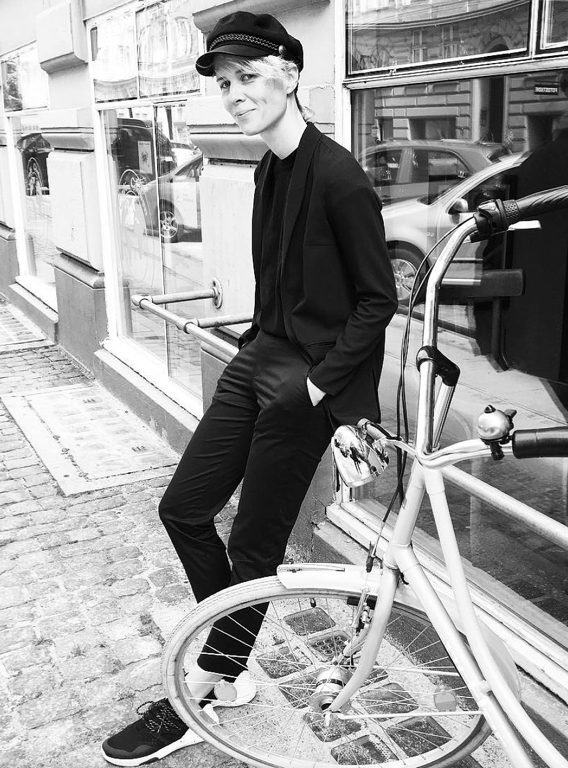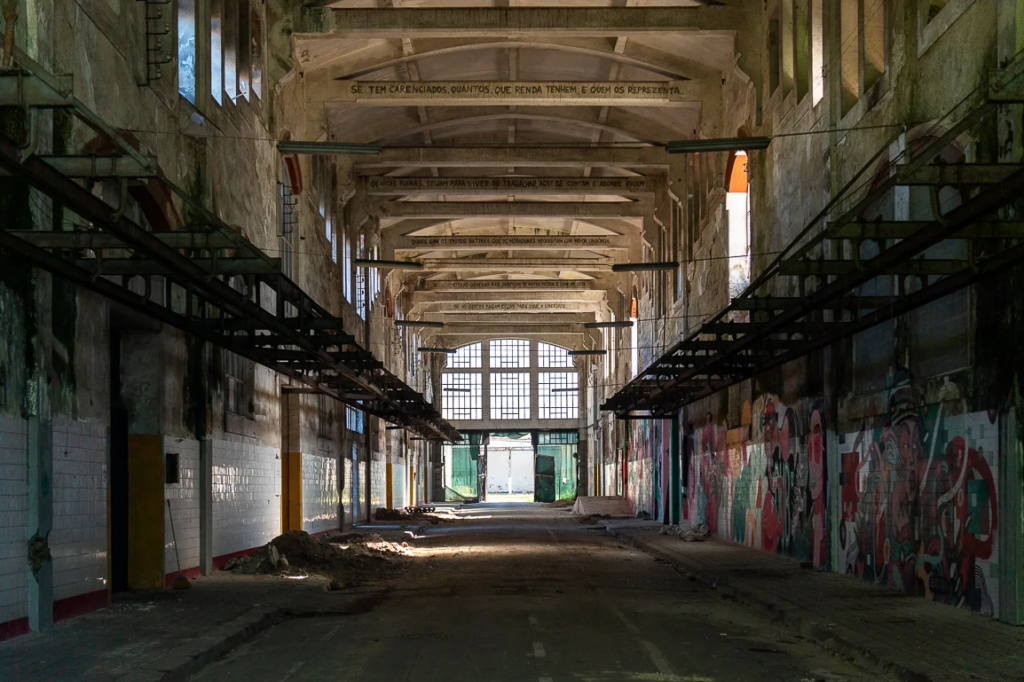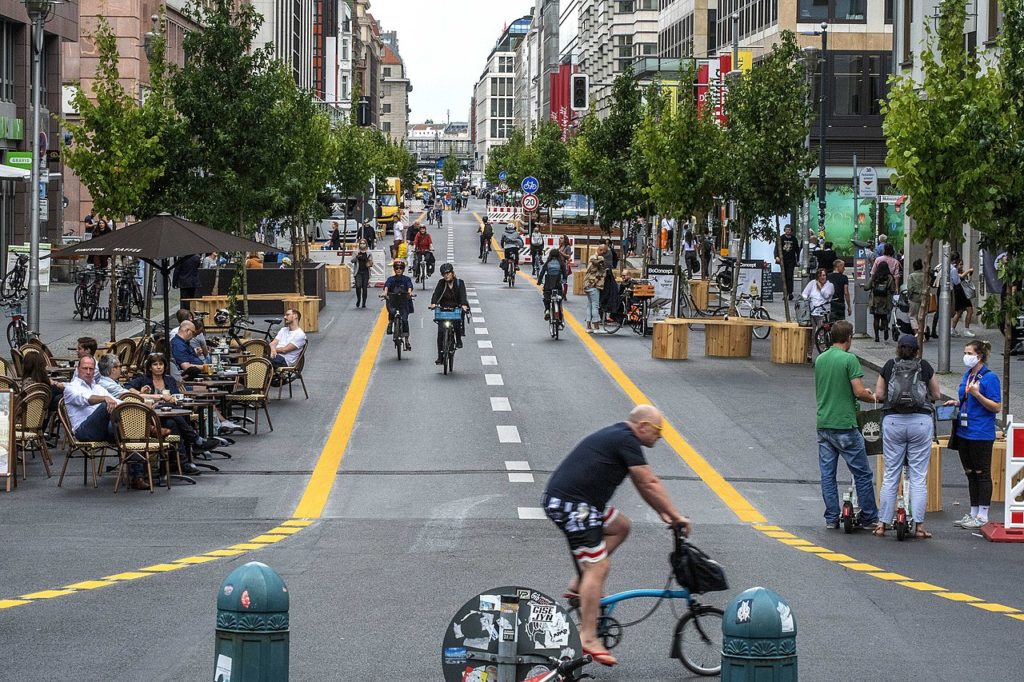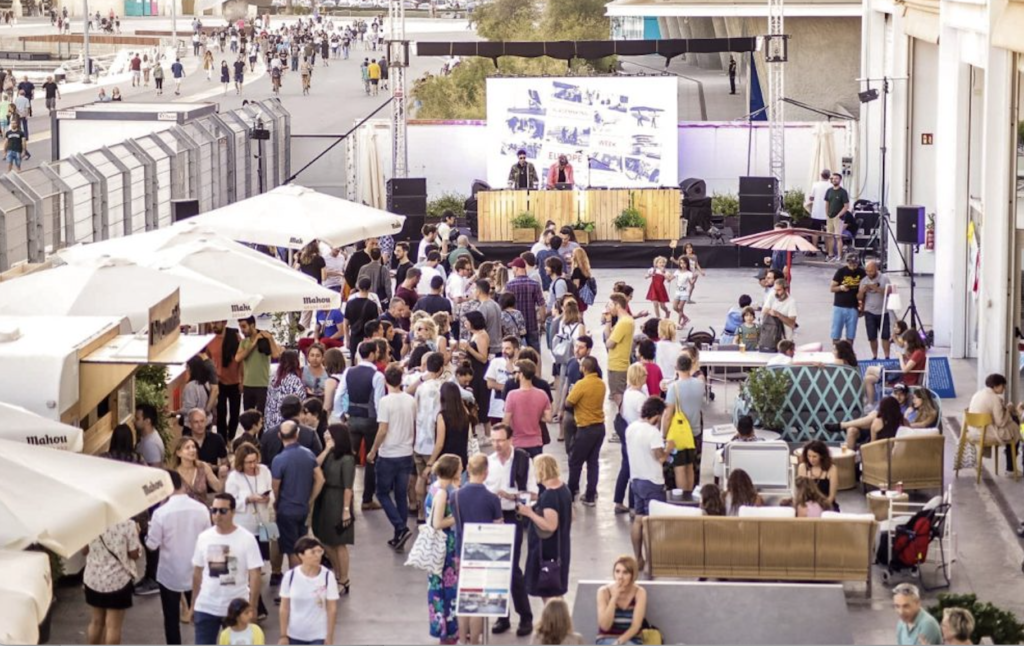Jenny Grettve is an architect, writer, artist and designer. With a broad background and years of experience in the architecture, design and fashion industries, she works as a creative consultant with a focus on conceptual work, rapid problem solving, interdisciplinary projects and productions. Jenny is part of the multi-disciplinary design team at Dark Matter Labs. Her areas of focus include spatial transformation, social integration, temporary urban projects, writing, architecture, art and modular structures, object design and exhibitions for the private and public sectors. We talked to Jenny Grettve about how to make cities more resilient to catastrophes, why we should collaborate and experiment more, and why this requires an economy of generosity.
The interview with Jenny Grettve took place on 16.09.2020. At the beginning of the pandemic, Sweden took a special path and introduced fewer and less drastic Covid measures – there were no compulsory masks and only mild restrictions in the restaurant trade. At the time of the interview, the number of new infections remained at a low level despite increased testing. However, Sweden was designated as a risk area as early as November 2020.
Urban Change Academy: How has the COVID pandemic influenced your life in Malmö in general, personally but also professionally?
Jenny Grettve: I’m in Sweden, so it hasn’t changed. My life is the same.
It hasn’t changed at all?
No, not really. I mean, we live more or less as we did before. And for me, personally, I had a little office, but we were only six people and that never closed, so it hasn’t changed at all. But I have changed the way I’m thinking about things, because I’m writing a book right now about retail spaces in cities and how those could be better used in the future. With COVID the uncertainties have grown, because you suddenly have all of these thoughts, „What happens if borders close completely?“. We won’t get any food from anywhere else, if we need to provide everything in cities, how do we do that? Where do we put things? So, in that book that I had, that was kind of mostly about, maybe more about the economy kind of shifted into, „Okay, how do we produce food inside, like in buildings? Or how can we quickly create 50 hospitals in a small city, in old stores, for example?“. So, those kinds of ideas were born, I think, when this hit the world.
We would like to understand more about what’s happening in the cities around COVID, and where you might see shifts, big or small, things that are changing or going into whatever direction. We’re really interested in these observations also when looking into other countries.
I was just reading this morning that there’s this kind of green wave. People want to produce their own food and are starting to set up their own gardens, farm and also buying houses in the countryside or even moving. A lot of young people are now moving to the countryside. I think we have this huge green wave, because you won’t travel anymore. For a while, at least. So I think there’s this huge shift in what we appreciate, which I think is fantastic, it was kind of needed. But when I talk to my friends in Australia or in the States, their lives have crashed. A lot of my friends don’t have work. They’re really mentally not well. So, it’s a weird feeling, being in Sweden at the moment.
I remember a New York Times article. In the economy section, there were a lot of very critical voices. And I think also in the German media, some articles were pretty negative. How did you perceive this kind of criticism?
It was so scary, because you feel like you’re in this kind of experiment. I felt like I was a little test rabbit. And the rest of the world is doing something else. You just go, „Should we just get a tent and go into the forest and be safe for a while?“.
So it put you under some kind of stress?
Of course, yes. Sweden is a strong democratic society where there’s a lot of trust in the government. So if the government says that this is correct, most people are going to trust them. I had a discussion with a friend the other day about that, he’s American and he said, „You know, in the States you’re born and from day one, they teach you not to trust the government or the system. I mean, don’t because it’s just full of corruption and crazy kinds of things, they want you to believe things that are maybe not correct, so don’t trust anything“. But the way I’m born is like, „Trust them“, that’s the only way to make this work. This contrast is kind of interesting, isn’t it?
You’re born in a certain culture and have more trust in the state. How do you see that kind of trust? What builds this trust in the Swedish government?
I actually gave him an example when we talked about this, because a while ago in Sweden, one minister, in a high post, she got fired because she happened to buy a chocolate bar with the business credit card of the party. I mean, that’s the level. If you happen to buy a chocolate bar with money that isn’t yours, you’re fired, you’re kicked, it doesn’t work. So I mean, the message is „You can trust us, we’re on track of things“. I’m guessing, but I think corruption, for example, is non-existent in Sweden. Or it must be done in a very, very clever way.
Which parts of a city might be affected by COVID and the pandemic in the future, what might change, what might stay, what might not – what are your observations?
Right now I am fully immersed in the work I’m doing for Dark Matter Labs. We work a lot with retrofitting, that I didn’t know much about before. In Europe alone, maybe around 250 million houses need to be changed to reduce their energy consumption. The walls and the roofs are not good enough, so we need to attach material on every single facade. That’s something that we, that every city and every country will have to do. That’s straight away something that I would add, because it’s a huge project.
I think production is going to be much more local, that’s also connected to the retrofit project. There are also a few projects already working on this, with open-source systems where you could download everything you would need for these types of constructions. So local production that may be with some kind of digital, open-source systems. Work and production need to be prepared for events like COVID, but that could also be different types of climate changes or whatever could happen. I think we need to be ready. Cities need to be ready to manage all of the production that they need.
So the question is, how can you make cities more resilient? And then it doesn’t matter really if it’s a pandemic or it’s climate change or any other kind of challenge.
For me, I think there is no need to talk about COVID only, but the idea of a world in change, in rapid change, and that we need to be prepared for whatever might hit us. I think this makes an interesting topic. As architects, do we need to start building in different ways? Do we need to think more about pandemics, or rising water levels? Do we need to construct the cities with emergency in mind? Do we actually need to shift this and create safe cities? It’s a discussion worth having. In Malmö (a coastal city) they’re already talking about rising sea levels, and the city needs to be constructed for this.
Let’s talk about neighborhoods. How might the pandemic change our relation to them?
I think the local area or the street you’re living in will become more important to you.
I kind of feel generous and happy towards my street. I waved to my hairdresser, and I buy my little flowers and I chit–chat a bit. I think when the world is a bit rocky, it’s all about the scale that feels safe and I think that’s something we could build on.
How?
This is very connected to the book I am working on about empty spaces: just where I live, there are five, six, eight empty stores that could be used for something way more interesting in this micro society. The project that I’m doing for the city of Malmö is going to take an example street and add things, some testbeds for the future. Something that I would like to add, that they don’t know yet, but also that Dark Matter Labs are working with a lot is, behavior patterns and consumption. If we do all of the work with carbon neutrality in our own cities, we’re still using the resources of a city somewhere else in the world. And is that really a carbon neutral city then? Right now those kinds of third emissions are not really taken into the equation, and I don’t think that people want to change their behavior. I mean, we want to add better facades, but we still want to go to H&M and buy cheap clothes. From my point of view, this is not going to work. And it’s very much connected to a new local approach, in how we live, and what we do.
We need to change the bigger picture?
Yes. Right now we are choosing the easy way. Sure, you can always add solar panels on your roof. But you don’t need to do any internal work in how you live or how you consume by adding those. But I think it’s going to be really important to act on a more holistic level in the future.
What else do we need to create better futures?
I think collaborations within communities are going to be something extremely important. And that will be added into everything here, like the green and nature, and culture, and open spaces, and work and production. We need to create better kinds of teamwork and collaborations. Another topic I’m extremely interested in right now is economy and generosity. I think that we will have to shift our whole perspective of cities, and that we need to be able to give and not expect to get anything back. I’m talking about big companies or institutions or cities. Or these store owners, I mean, they are right now just sitting on space because it’s cheaper for them. So I think we need to move away from money only, and think about humans. What’s good, what is going to be good for the city in another kind of holistic perspective? It’s about becoming a more generous economy.
There is the citizen level and there is the communal, the steering of the city. Do you think the official administrative part will be more important in post COVID times?
I don’t think it’s going to be more or less important, but I think that the administrations are as well shifting the way they see things. This afternoon, I’m doing a workshop in Sweden with Vinnova and Viable Cities, ten cities, to take a deep dive into these topics. I think cities are quite interested in this change, and they know that they have to work on it. They are looking for different, new approaches.
Back to carbon neutrality: there is a deadline, when it comes to sustainability and it’s very close. So it’s not just about kind of wanting to change, they have to.
So it’s important to refocus back on the whole issue of climate change, sustainability and not being stuck too much with the pandemic?
Yes. I am guessing this pandemic is going to pass eventually. I mean, hopefully it’s not something that’s going to stay. It might stay for six months more in Sweden or one more year I don’t know- but I think there’s a timeframe on it. I think it’s always important to keep your vision at a longer perspective in time. But it’s also very interesting to think more about the effects of the pandemic. Dark Matter Labs did a risk cascade analysis of COVID, and specifically about closing societies, and what happens, and the long-term risks. So all this is something to consider.
How does the pandemic change our outlook into the future? Does it change what we think is possible?
I think it opened many people’s eyes that we can’t control what’s going to happen, and we need to be prepared for whatever could come. It’s harsh, but maybe also important to be ready for those things. As someone said here in Sweden in the beginning: this is just a trial, the real thing is going to come soon, and then at least now we’re a little bit more prepared. It sounds scary, but I think it is true.
Who do you think are the people competent enough to navigate this future or to design it?
I think this question leads us back to collaboration again. I don’t think there is one kind of approach like okay, well, it’s going to be the cities to solve this, or it’s the architects. This is a huge team effort. I had a meeting last week with a city that was open for this idea of generosity and sharing. I think it’s super important that we stop being egoistic, and that we’re willing to give more than we want to get back. This also needs to be reflected in open-minded teamwork and a sharing attitude.
How does this influence your work as a designer?
I did a few kinds of pop–up parks last year. I’m not so interested in doing that anymore. I don’t know. It just felt almost meaningless. So the way I see my work has changed, shifted a lot. I feel that I have responsibilities which I maybe didn’t feel before.
If you work with cities and have the opportunity to design, I think this is what you should work on right now. I don’t want to do a nice bench.
When you look at institutions, cities, governments, which skills or work modes in your view, are important in the future, which are we missing at the moment and which might be developed in the future?
What we are helping cities right now with Dark Matter Labs is providing the big overviews, systemic strategies. I think that’s something which is strongly needed. It’s hard to know everything that’s going on within the world. To keep this long vision alive and not fall into, as we said, fall into COVID, but to keep a good overview. Almost like management of a long-term survival.
I also see great kinds of workshop formats or sprints. The people who are super good at those things can jump in and do mini-interventions. I think that’s a great resource which is often missed. I also noticed from the cities that we’ve talked to, that they’re asking for advice around business models and different ways of funding, because of course there’s always a lack of money. At the same time, there are lots of really cool initiatives, where people pay a certain kind of tax, or community budgets, there’s so many different ways going on in how we see the economy, and how the economy can work in a city. I think economy and funding is a very interesting topic for cities right now.
It is tricky. The cities themselves don’t know what they need to do, and they don’t know what they’re missing, they don’t know how to get there. There’s a lack of information, but also a lack of results. For example, testbeds are interesting. This is also new and there are not many cities that are doing things that you can look at already. We’re still just in the beginning of trying all these new kinds of things like solar panels, retrofit, changing consumption or whatever. I mean, so give it another few years and there might be better examples, but today there are very few. This also makes it hard to have cities on board, when they don’t know exactly what you’re talking about, or when you don’t have examples you can show, like, „This is what the city did, you should do the same“.
So we need more tangible examples, best practices?
That’s always good. I mean, there are not many people in the world who are brave enough to try things that haven’t been tested before.
Which specific courses would like to see in the Urban Change Academy?
It would be interesting to mix high and low. I mean, I think it would be super interesting to see a course in long-term strategies about sustainability for cities, that kind of run for the next ten years. What is that? And then you have a course about those things and what to think about and what not to forget, different types of mapping systems or whatever. But then I also think that it’s super cool to dive really deep and go, „Okay, how can we make every single corner in the city to an urban farm?“, and they learn about carrots, very practical. I think there is maybe a space for both high and low.
Interesting idea!
I think it’s important. I think we need to do both. Both of these need to run at the same time. We can’t just do the strategies and do nothing else for two years, and then suddenly go into the testbeds. I also think that these two should inspire each other. Whatever you test in the street, you also bring along in the strategy once it’s tested, and you will find out whether it works or not.
What knowledge would you be interested in sharing?
Right now, I’m super interested in this kind of small–scale experiments. Like, you take a street or a mini community and you try, let’s say, 20 ideas. What happens if we give all of these, let’s say, it’s ten houses. We give them the information about consumption on the fashion industry, we tell them how they can add solar panels. We give them all the clues that they need to create a mini sharing community on that street. We tell them about the energy and how to reduce the energy use at home. We give them new power sockets to try out and see if that changes something. Mini trials, but connected to bigger ideas, that’s something I’m super interested in doing. And also to try those and then, „Okay, this kind of a solar panel thing went amazing. Let’s try it in 25 percent of the city, instead of just one street“. Start small, experiment. And then if we think it worked well, scale it.
Thank you very much.
Bildquelle: © Jenny Grettve




